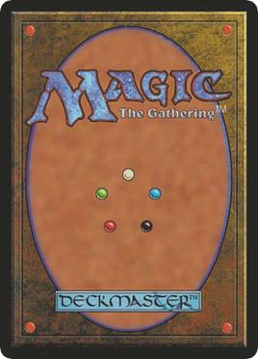 Art by Omar Rayyan
Art by Omar RayyanFriendly Neighborhood Jumpstart Cube
Inspired by michael921's jumpstart cube and associated guide
Welcome to your friendly neighborhood jumpstart cube! This is a peasant cube that's designed to be played like the jumpstart format. Each player selects two mono-color 20-card packs and shuffles them together to create a single ready-to-play 40-card deck. The packs are preconstructed and contain 12 spells, 1 dual-land, and 7 basic lands.
This cube is designed with the new-player experience in mind. My hope is that it strikes a nice balance between complexity for experienced players and approachability for newer players. It is also intended to be a budget-friendly cube. Right now, the total cost to purchase all of the cards in this cube is around $15.
Packs
Here's a list of all 10 packs in this cube. For more on my design philosophy, see the below section.
 Humans
Humans
 Monks
Monks
 Merfolk
Merfolk
 Spirits
Spirits
 Zombies
Zombies
 Vampires
Vampires
 Goblins
Goblins
 Artificers
Artificers
 Elves
Elves
 Beasts
Beasts
Design
I had a few related design goals when building this cube:
- Each pack should be distinctive in flavor and playstyle. 'Elves' should feel like elves, but also play differently when combined with 'Zombies' as opposed to 'Spirits'.
- Each combination of packs should play well together, and all be (within reason) balanced against one another. Of course, 'Zombies' and 'Goblins' will have some clear overlap, but I also want 'Zombies' to play well with 'Elves', 'Artificers', 'Humans', and the rest!
- As stated in the introduction, the decks should strike a good balance of complexity and approachability. Think more complicated than welcome decks, but less complicated than your average constructed deck.
- Prefer cards with reminder rules text, and avoid cards without reminder text for non-evergreen mechanics.
- Try to minimize 'feel bad' moments. This means prefer cards that are useful in all matchups (e.g., no overly narrow removal cards or color-specific hate), and try to avoid (or at least minimize) mechanics that work against one another (e.g., Delve and Threshold).
There are ten total packs in version 1.0 of this cube. My thought is that this could support up to four players at any one time (eight of the ten packs could be combined into four decks). As far as flavor goes, each pack is themed around a creature type: the five characteristic creature types—Humans, Merfolk, Zombies, Goblins, Elves—and five creature types that I thought would be interesting and/or fit some other design goal—Monks, Spirits, Vampires, Artificers, Beasts. For reasons I'll discuss below, it might be a good idea in your playgroup to enforce a prohibition on combining two packs of the same color.
How to ensure that each combination of packs plays well together? As with a few past cubes I've designed, my central idea was to give each color wedge a loose archetype...
- Abzan (


 ): Counters
): Counters - Jeskai (


 ): Noncreature spells ('Spellslinger')
): Noncreature spells ('Spellslinger') - Sultai (


 ): Graveyard
): Graveyard - Mardu (


 ): Artifacts & Enchantments
): Artifacts & Enchantments - Temur (


 ): Enter-the-Battlefield Effects
): Enter-the-Battlefield Effects
...so each color would have three associated archetypes:
 : Counters, Noncreature Spells, Artifacts & Enchantments
: Counters, Noncreature Spells, Artifacts & Enchantments : Noncreature Spells, Graveyard, Enter-the-Battlefield Effects
: Noncreature Spells, Graveyard, Enter-the-Battlefield Effects : Counters, Graveyard, Artifacts & Enchantments
: Counters, Graveyard, Artifacts & Enchantments : Noncreature Spells, Artifacts & Enchantments, Enter-the-Battlefield Effects
: Noncreature Spells, Artifacts & Enchantments, Enter-the-Battlefield Effects : Counters, Graveyard, Enter-the-Battlefield Effects
: Counters, Graveyard, Enter-the-Battlefield Effects
So, for the twelve spells in each pack, I began with the following formula (a slight twist on what michael921 wrote in his guide on jumpstart cubes):
The Pack Formula
3x cards for archetypes 1+2
3x cards for archetypes 2+3
3x cards for archetypes 1+3
4x flex (whatever's needed: curve filler, removal, or draw)
The Pack Formula is less a hard rule and more a loose guide or starting point (I'm not sure if any pack perfectly matches up to the Pack Formula!). Let's break down one pack as an example: Goblins. Goblins is a red deck, and so it has three archetypes to account for: Noncreature Spells, Artifacts & Enchantments, Enter-the-Battlefield Effects. Goblins should also have something distinctive about it that makes it feel like a goblins pack, as opposed to a generic pack that's squeezed between three red archetypes. So, in addition to the three red archetypes, I've given Goblins a few cards that care about the goblin creature type or involve sacrificing goblins. If we look at the break-down of the pack by archetype, here's what we find:
Noncreature Spells/'Spellslinger': Guttersnipe, Goblin Wizardry, Goblinslide, Dragon Fodder, Goblin Barrage
Artifacts & Enchantments: Goblin Firebomb, Redcap Thief, Goblin Morningstar, Makeshift Munitions, Goblinslide, Goblin Barrage
Enter-the-Battlefield Effects: Goblin Shortcutter, Redcap Thief, Beetleback Chief, Volley Veteran
Goblin-type-matters/Sacrifice: Volley Veteran, Goblin Barrage, Makeshift Munitions (+ the many cards that make goblin tokens!)
When combined with Humans, Goblins provides artifacts and enchantments for Trusty Retriever, Rosecot Knight, and Michiko's Reign of Truth. When combined with Merfolk, Goblins has a few instant and sorcery spells to trigger prowess on Triton Wavebreaker or be recovered by Shipwreck Dowser, and powerful ETB-effects to be recurred with Run Away Together. When combined with Zombies, Goblins provides artifacts to reduce the cost of Refurbished Familiar and sacrifice outlets like Makeshift Munitions and Goblin Barrage. And so on!
You might notice a few weaknesses of this design approach. First, allied-color pairs are slightly disadvantaged over enemy-color pairs. This is because allied-color pairs only have one archetype in common, whereas enemy-color pairs have two archetypes in common (e.g., red and black only share the 'Artifacts and Enchantments' archetype, whereas red and blue share both the 'Spellslinger' and 'ETB-effects' archetypes). Second, mono-color decks (decks that combine two packs of the same color, like Humans+Monks or Goblins+Artificers) will likely turn out stronger than two-color decks. This is because they will share all three archetypes, as opposed to only one or two.
As I playtest this cube, I'll likely make changes and improvements. I may wind up abandoning the wedge-based approach if it turns out to be too challenging to balance or too unwieldy to design around. I may also wind up abandoning the peasant format and including a few budget rares.
Purchasing this Cube
To assemble this cube, you need to acquire:
- 130 non-basic-land cards (I explain below how to automatically import the cube to a TCGPlayer cart.)
- 70 basic lands, 14 of each type
- Tokens (This is optional. The full list of tokens can be found here.)
- Sleeves, cube storage, dice, etc. (For sleeves, I recommend Dragon Shield Matte Sleeves. For storage, I like the Clear Cubemajigs 10-Pack, as this includes small clear plastic boxes for each 20-card pack and a cardboard box to store all ten packs.)
To import the entire list from Cubecobra to TCGPlayer:
- Go to the list page of the clone of the cube without basic lands.
- On the top left of the screen, change the default 'Table View' to 'List View'.
- Next to where it says 'Name' at the top of the list of cards, click the checkbox to select all cards.
- Click 'Edit 130 Cards'.
- Click 'Buy All' in the bottom left corner of the window that pops up. This will take you to a TCGPlayer cart with all of the cards added.
My guess is that the actual price of purchasing this cube will vary from roughly $50-100, depending on which what you already own and which supplemental products you decide to purchase (tokens, sleeves, storage, etc.). If you already own basic lands, then the 130 non-basic-land cards, Dragon Shield sleeves, and Cubemajigs storage will total $60, which is about the price of a board game.
Ideas for the Future
There are many other creature types that I think would work well in this cube. Here's a list of creature types in each color that I might consider for a potential expansion:
 : Angels, Cats, Giants, Soldiers, Clerics, Samurai, Pilots, Knights
: Angels, Cats, Giants, Soldiers, Clerics, Samurai, Pilots, Knights : Sphinxes, Wizards, Faeries, Frogs, Birds, Ninjas, Rogues
: Sphinxes, Wizards, Faeries, Frogs, Birds, Ninjas, Rogues : Demons, Rats, Pirates, Nightmares, Skeletons, Warlocks, Mercenaries
: Demons, Rats, Pirates, Nightmares, Skeletons, Warlocks, Mercenaries : Dragons, Dinosaurs, Elementals, Devils, Dwarves, Ogres
: Dragons, Dinosaurs, Elementals, Devils, Dwarves, Ogres : Hydras, Treefolk, Fungi, Squirrels, Werewolves, Druids, Snakes
: Hydras, Treefolk, Fungi, Squirrels, Werewolves, Druids, Snakes
Feel free to comment under this post with feedback or thoughts on the Friendly Neighborhood Jumpstart Cube!

